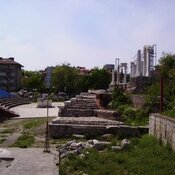Er zijn nog geen Nederlandstalige annotaties. Hier volgen annotaties in het Engels.
The mine at Ai Bunar is roughly contemporary with the mine at Rudna Glava, and the miners used similar techniques. They excavated narrow open trenches to follow the veins of copper carbonates into the hills. As at Rudna Glava, archaeologists found antler picks and stone mauls in the mine shafts, in addition to two shaft-hole copper tools and the remains of three human individuals.
The ceramics found at Ai Bunar are characteristic of the ceramics found in the sixth layer at the Karanovo tell (Karanovo VI) and date to the late fifth millennium B.C. While this discovery demonstrates that the mines at Ai Bunar were in use during the later fifth millennium B.C., other evidence suggests the mines probably were in use somewhat earlier, possibly as early as the end of the sixth millennium B.C. Copper objects and ore that have been demonstrated chemically to have derived from the sources at Ai Bunar were found at several sites in south-central Bulgaria that are contemporary with Karanovo V, a phase that dates to the beginning of the fifth millennium B.C.
Chemical analyses, primarily lead isotope analyses, carried out by E. N. Chernykh, Noël H. Gale, and several Bulgarian specialists have demonstrated that Ai Bunar and Rudna Glava were not the only sources for copper ore in prehistory. The analysis of copper artifacts from several sites in south-central Bulgaria suggests that at least four other copper sources were exploited, though they remain unidentified.
The mine at Ai Bunar is roughly contemporary with the mine at Rudna Glava, and the miners used similar techniques. They excavated narrow open trenches to follow the veins of copper carbonates into the hills. As at Rudna Glava, archaeologists found antler picks and stone mauls in the mine shafts, in addition to two shaft-hole copper tools and the remains of three human individuals.
The ceramics found at Ai Bunar are characteristic of the ceramics found in the sixth layer at the Karanovo tell (Karanovo VI) and date to the late fifth millennium B.C. While this discovery demonstrates that the mines at Ai Bunar were in use during the later fifth millennium B.C., other evidence suggests the mines probably were in use somewhat earlier, possibly as early as the end of the sixth millennium B.C. Copper objects and ore that have been demonstrated chemically to have derived from the sources at Ai Bunar were found at several sites in south-central Bulgaria that are contemporary with Karanovo V, a phase that dates to the beginning of the fifth millennium B.C.
Chemical analyses, primarily lead isotope analyses, carried out by E. N. Chernykh, Noël H. Gale, and several Bulgarian specialists have demonstrated that Ai Bunar and Rudna Glava were not the only sources for copper ore in prehistory. The analysis of copper artifacts from several sites in south-central Bulgaria suggests that at least four other copper sources were exploited, though they remain unidentified.





![Forum Stara Zagora [Augusta Traiana]](https://images.vici.org/crop/w175xh175/uploads/stara_zagora_mosaic_baths_facade_2_ab.jpg)